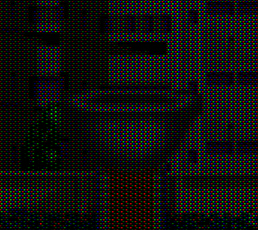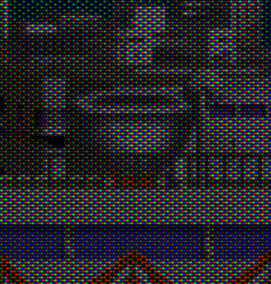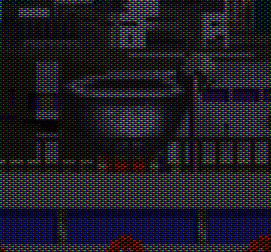At 3x scaling things start to look convincing.

This preset is a proof of concept that scales the horizontal mask by 3x, set the shadowmask phosphor height to 3, staggers horizontally by 1.5x and with the help of vertical mask, set at 3x (screen coords), gives phosphors a rounder look vertically too for what is possible with 3x3 px.
Naked, it does not uses bloom halo or else.
…also i’ve another change for the code in mind, but this is dangerous, since it would affect basically everything and i can’t remember why the code was that way lol 
It would allow to have rounder phosphors; this is almost the same as before, 3X

This is the same as before, but for 2x scaling, blockiness is unavoidable here (every phosphor is a 2x2 square), but still we may smooth one out of 2 pixels to have something smoother.

4K is really needed when using lower TVL, or moire will kick in.
Shadowmask 3x
IN_GLOW_POWER = "1.500000"
LUMINANCE = "0.200000"
TEMPERATURE = "7200.000000"
IN_GLOW_GAMMA = "2.000000"
GAMMA_OUT = "0.400000"
OFFSET_STRENGTH = "0.300000"
SHIFT_R = "-20.000000"
SHIFT_G = "0.000000"
SHIFT_B = "20.000000"
IN_GLOW_W = "-0.800000"
IN_GLOW_H = "7.000000"
RESSWITCH_GLITCH_SIZE = "0.000000"
DO_PIXELGRID = "1.000000"
DO_PIXELGRID_H = "0.000000"
PIXELGRID_MIN_H = "0.500000"
PIXELGRID_MAX_H = "0.700000"
PIXELGRID_GAMMA_H = "5.200000"
PIXELGRID_MUL_X = "3.000000"
PIXELGRID_H_PRST = "0.000000"
PIXELGRID_G_SHIFT = "1.000000"
PIXELGRID_B_SHIFT = "2.000002"
PIXELGRID_MIN_W = "0.200000"
PIXELGRID_MAX_W = "0.300000"
PIXELGRID_GAMMA_W = "5.199997"
PIXELGRID_BASAL_GRID = "0.020000"
PIXELGRID_Y_MASK = "1.000000"
PIXELGRID_Y_MASK_HEIGHT = "-1.500000"
PIXELGRID_Y_MASK_OFFSET = "0.000000"
PIXELGRID_Y_MASK_SHIFT = "0.000000"
PIXELGRID_Y_MASK_STEEP = "1.000000"
PIXELGRID_Y_MASK_ON_WHITE = "0.150000"
PIXELGRID_DO_SHADOWMASK = "1.000000"
PIXELGRID_SHADOWMASK_SHIFT = "1.500000"
PIXELGRID_SHADOWMASK_H = "3.000000"
HALO_NO_PREGAIN = "1.000000"
HALO_POWER = "0.500000"
HALO_SHARPNESS = "6.500000"
HALO_VS_SCAN = "0.700000"
BLOOM_MIX = "0.400000"
BLOOM_GAMMA_OUT = "1.200000"
BLOOM_EYE_ADPT_SRT = "0.600000"
BLOOM_EYE_INERTIA = "750.000000"
GEOM_CORNER_SIZE = "0.010000"
GEOM_CORNER_SMOOTH = "200.000000"
DO_BEZEL = "1.000000"
BEZEL_INNER_ZOOM = "-0.010000"
BEZEL_FRAME_ZOOM = "0.170000"
DO_VIGNETTE = "1.000000"
V_SIZE = "1.080000"
DO_SPOT = "1.000000"
S_POWER = "0.050000"```
Shadowmask 2x
IN_GLOW_POWER = "1.500000"
LUMINANCE = "0.200000"
TEMPERATURE = "7200.000000"
IN_GLOW_GAMMA = "2.000000"
GAMMA_OUT = "0.400000"
OFFSET_STRENGTH = "0.300000"
SHIFT_R = "-20.000000"
SHIFT_G = "0.000000"
SHIFT_B = "20.000000"
IN_GLOW_W = "-0.800000"
IN_GLOW_H = "7.000000"
RESSWITCH_GLITCH_SIZE = "0.000000"
DO_PIXELGRID = "1.000000"
DO_PIXELGRID_H = "0.000000"
PIXELGRID_MIN_H = "0.500000"
PIXELGRID_MAX_H = "0.700000"
PIXELGRID_GAMMA_H = "5.200000"
PIXELGRID_MUL_X = "2.000000"
PIXELGRID_H_PRST = "0.000000"
PIXELGRID_B_SHIFT = "2.000002"
PIXELGRID_MIN_W = "0.140000"
PIXELGRID_MAX_W = "0.300000"
PIXELGRID_GAMMA_W = "5.199997"
PIXELGRID_BASAL_GRID = "0.020000"
PIXELGRID_Y_MASK = "1.000000"
PIXELGRID_Y_MASK_HEIGHT = "-1.000000"
PIXELGRID_Y_MASK_OFFSET = "0.000000"
PIXELGRID_Y_MASK_STEEP = "1.000000"
PIXELGRID_Y_MASK_ON_WHITE = "0.150000"
PIXELGRID_DO_SHADOWMASK = "1.000000"
PIXELGRID_SHADOWMASK_SHIFT = "1.500000"
PIXELGRID_SHADOWMASK_H = "2.000000"
HALO_NO_PREGAIN = "1.000000"
HALO_POWER = "0.500000"
HALO_SHARPNESS = "6.500000"
HALO_VS_SCAN = "0.700000"
BLOOM_MIX = "0.400000"
BLOOM_GAMMA_OUT = "1.200000"
BLOOM_EYE_ADPT_SRT = "0.600000"
BLOOM_EYE_INERTIA = "750.000000"
GEOM_CORNER_SIZE = "0.010000"
GEOM_CORNER_SMOOTH = "200.000000"
DO_BEZEL = "1.000000"
BEZEL_INNER_ZOOM = "-0.010000"
BEZEL_FRAME_ZOOM = "0.170000"
DO_VIGNETTE = "1.000000"
V_SIZE = "1.080000"
DO_SPOT = "1.000000"
S_POWER = "0.050000"```






















